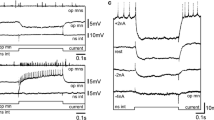Summary
In papers I and II of this series, we described two pairs of interneurons, Tr1 and Tr2, in the leech subesophageal ganglion which can trigger swimming activity in the isolated central nervous system (CNS). In this paper, we describe sensory inputs to these trigger neurons from previously identified mechanosensory neurons. We found that:
-
1.
Weak mechanical stimulation (stroking) of a body wall flap attached to a segmental ganglion in an otherwise isolated CNS excites the contralateral Tr1 slightly. Strong mechanical stimulation (pinching) of a mid-body wall flap evokes a burst of impulses in the contralateral Tr1. For both means of stimulation the effects on the ipsilateral Tr1 and on the Tr2 cell pair were much weaker.
-
2.
Stroking a body wall flap attached to the head ganglion (supra- and subesophageal ganglia) in an otherwise isolated CNS excites both Tr1s and both Tr2s, although the effect is weaker for the Tr2s. Pinching strongly excites both trigger neurons bilaterally.
-
3.
Pressure and nociceptive mechanosensory neurons (P and N cells) in the subesophageal ganglion and the first segmental ganglion appear to make direct excitatory synapses with the contralateral Tr1 and Tr2. Mechanosensory interactions with the ipsilateral trigger neurons appear to be indirect.
-
4.
Functional inactivation of Tr1 by hyperpolarization does not prevent swim initiation either by weak mechanical stimulation of a body-wall flap or by intracellular stimulation of P cells.
-
5.
We conclude that the trigger neurons, Tr1 and Tr2, provide an excitatory pathway by which mechanosensory stimulation can initiate leech swimming activity. This pathway appears more important for strong than for weak mechanical stimulation. Since activity in the Tr1 pair is not required for swim initiation by some forms of stimulation, additional pathways leading from mechanosensory neurons to the oscillator network remain undiscovered.
Similar content being viewed by others
Abbreviations
- SII :
-
swim-initiating interneuron
- CNS :
-
central nervous system
References
Berry MS, Pentreath VW (1976) Criteria for distinguishing between monosynaptic and polysynaptic transmission. Brain Res 105:1–20
Brodfuehrer PD (1986) Control of swimming activity in the medicinal leech by the head brain. Doctoral dissertation, University of Virginia
Brodfuehrer PD, Friesen WO (1986) Initiation of swimming activity by trigger neurons in the leech subesophageal ganglion. I. Output connections of Tr1 and Tr2. J Comp Physiol A 159:489–502
Debski EA, Friesen WO (1985) Habituation of swimming activity in the medicinal leech. J Exp Biol 116:169–188
Eaton RC (1982) Is the Mauthner cell a vertebrate command neuron? In: Ewert J-P, Capranica RR, Ingle D (eds) Advances in vertebrate neuroethology. Plenum Press, New York, pp 629–636
Elliott EJ (1985) Leech lip sensilla detect NaCl and arginine in blood. Chem Senses 10:461
Friesen WO (1981) Physiology of water motion detection in the medicinal leech. J Exp Biol 92:255–275
Friesen WO, Brodfuehrer PD (1984) Identification of neurons in the leech through local ionic manipulations. J Exp Biol 113:455–460
Kretz JR, Stent GS, Kristan WB Jr (1976) Photosensory input pathways in the medicinal leech. J Comp Physiol 106:1–37
Kristan WB Jr, McGirr SJ, Simpson GV (1982) Behavioral and mechanosensory neurone responses to skin stimulation in leeches. J Exp Biol 96:143–160
Kupfermann I, Weiss KR (1978) The command neuron concept. Behav Brain Sci 1:3–39
Mann KM (1962) Leeches (Hirudinea): Their structure, physiology, ecology and embryology. Pergamon, New York
Muller KJ, Nicholls JG, Stent GS (1981) Neurobiology of the leech. Cold Spring Harbor Laboratory. Cold Spring Harbor, New York
Nicholls JG, Baylor DA (1968) Specific modalities and receptive fields of sensory neurons in the CNS of the leech. J Neurophysiol 31:740–756
Nicholls JG, Purves D (1970) Monosynaptic chemical and electrical connexions between sensory and motor cells in the central nervous system of the leech. J Physiol (Lond) 225:637–656
Nolen TG, Hoy RR (1983) Initiation of behavior by single neurons: The role of behavioral context. Science 226:992–994
Nusbaum MP, Kristan WB Jr (1982) The swim-initiating ability of intersegmental serotonin-containing leech interneurons. Neurosci Abstr 8:161
Olson GC, Krasne FB (1981) The crayfish lateral giants as command neurons for escape behavior. Brain Res 214:89–100
Weeks JC (1982a) Segmental specialization of a leech swiminitiating interneuron, cell 205. J Neurosci 2:972–985
Weeks JC (1982b) Synaptic basis of swim initiation in the leech. II. A pattern-generating neuron (cell 208) which mediates motor effects of swim-initiating neurons. J Comp Physiol A 148:265–279
Weeks JC, Kristan WB Jr (1978) Initiation, maintenance and modulation of swimming in the medicinal leech by the activity of a single neuron. J Exp Biol 77:71–88
Wiersma CAG, Ikeda K (1964) Interneurons commanding swimmeret movements in the crayfish,Procambarus clarkii (Girard). Comp Biochem Physiol 12:509–525
Yau KW (1976) Physiological properties and receptive fields of mechanosensory neurons in the head ganglion of the leech: Comparison with homologous cells in segmental ganglia. J Physiol (Lond) 263:489–512
Young SR, Dedwyler RDII, Friesen WO (1981) Responses of the medicinal leech to water waves. J Comp Physiol 144:111–116
Author information
Authors and Affiliations
Rights and permissions
About this article
Cite this article
Brodfuehrer, P.D., Friesen, W.O. Initiation of swimming activity by trigger neurons in the leech subesophageal ganglion. J. Comp. Physiol. 159, 511–519 (1986). https://doi.org/10.1007/BF00604171
Accepted:
Issue Date:
DOI: https://doi.org/10.1007/BF00604171




